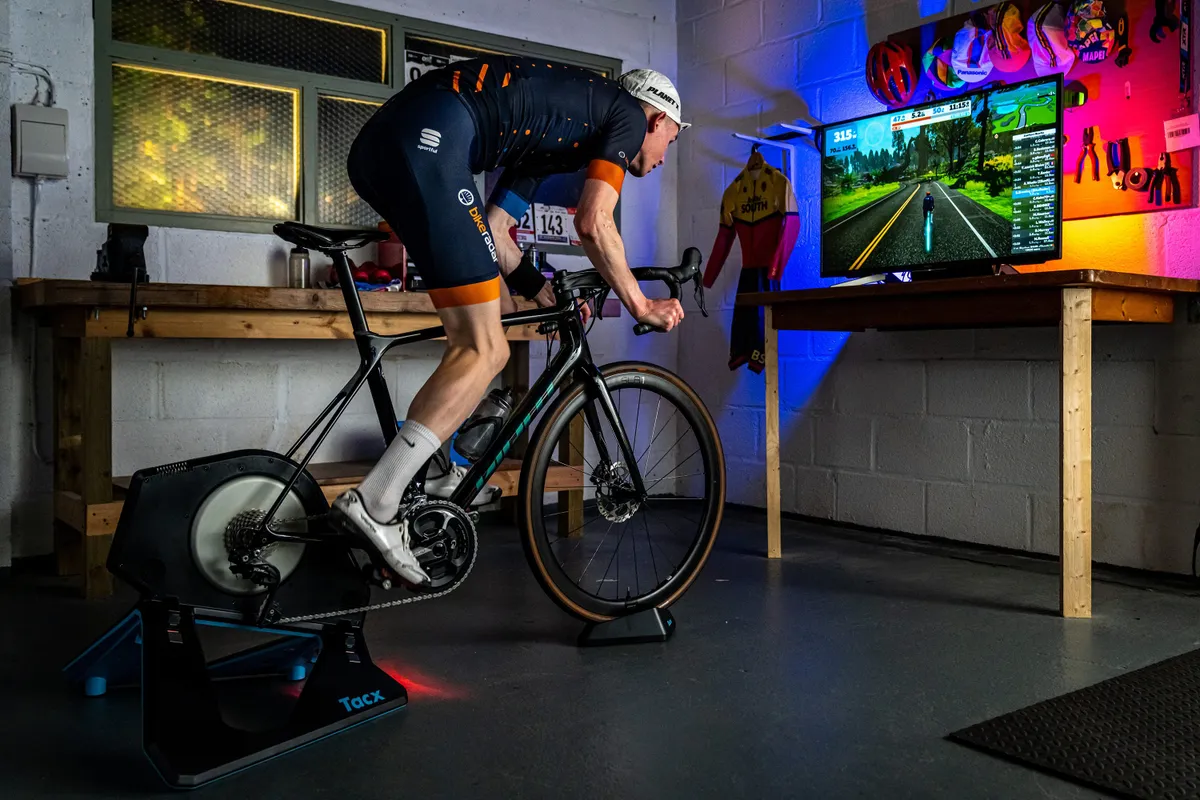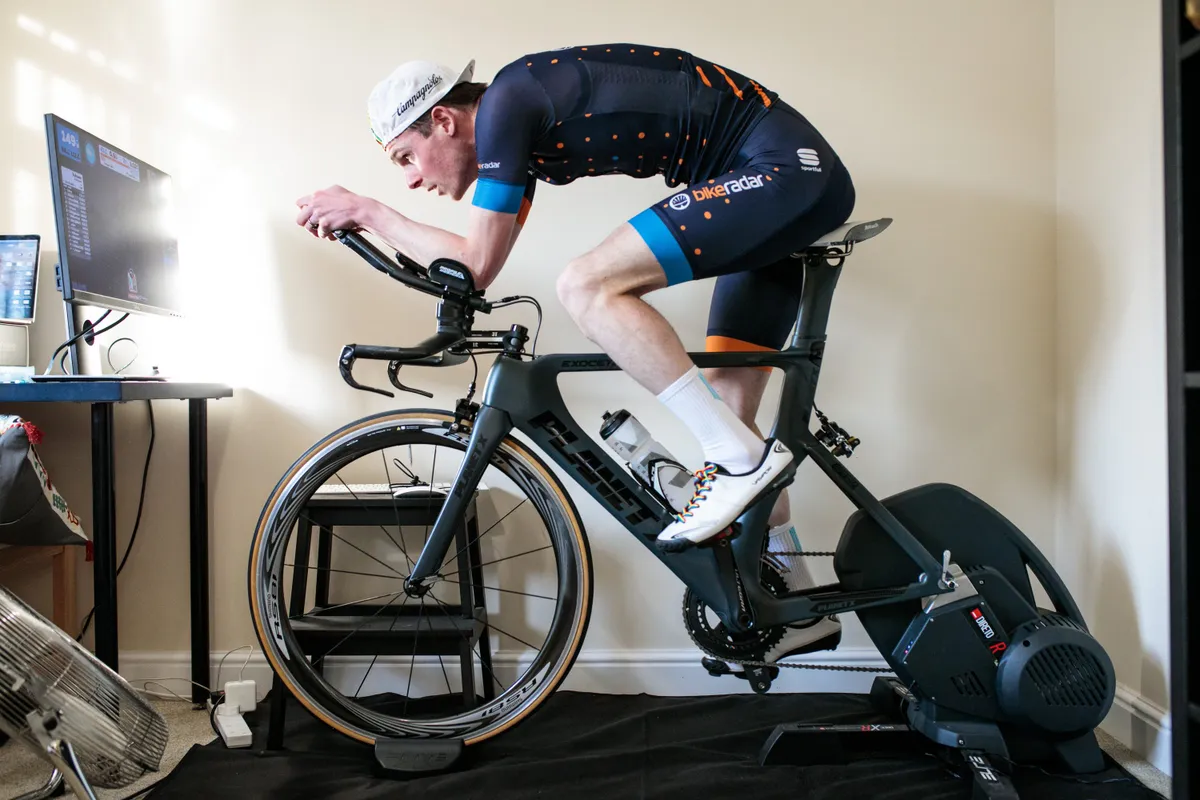Ultra-distance events are growing in popularity as more riders look beyond sportives and Gran Fondos for a challenge.
From gravel racing and Ironman triathlons to multi-day bikepacking trips, ultra riding let’s you settle in for the long haul, regardless of whether you’re competing at the sharp end of a race or admiring the view along the way.
Preparing yourself for an ultra-distance ride doesn’t have to involve slogging away for hours in all conditions, though. In fact, it’s possible to train without stepping out of your front door.
Indoor cycling apps such as Zwift can help you prepare for every stage of your ultra-distance training journey – whether that’s settling in for long sessions in the saddle, dragging up your VO2 max with short, sharp efforts or bedding in new equipment.
Here’s how you can use Zwift to train for an ultra-distance event.
1) Explore Zwift’s new routes

While it’s not all about base training miles, preparing for an ultra-distance ride does, in part, mean settling in for some serious time in the saddle to work on your endurance fitness.
Fortunately, this is where Zwift’s ever-expanding virtual worlds can come into play.
Whether you opt to ‘free ride’ and choose your own path or select one of the hundreds of pre-programmed routes, there are thousands of miles of virtual ground to explore.
The platform is regularly adding new maps and routes too, meaning you can keep things fresh and ride in a different virtual location during each session.
Recent highlights include the launch of the Urukazi map in the Makuri Islands world. It features eight new routes, including Makuri 40 – a 40km loop that takes riders through all three of the world’s maps.
Zwift is also adding a Scotland map, with five new routes, in early 2023.
2) Go big

Long rides needn’t be an option only in the great outdoors.
In fact, Zwift has a couple of routes in its arsenal that would rival the hardest days on the road, in terms of distance and elevation.
If you’re looking to truly test your climbing legs, look no further than The Über Pretzel. When it was released, the 128.3km route covered every bit of tarmac in the Watopia world, but it’s the elevation that will get your heart pumping.
Featuring the passes of Epic KOM and Volcano KOM, the route finishes with the turn-by-turn recreation of Alpe d’Huez – the 12km, 8.5 per cent average gradient of Alpe du Zwift.
Alternatively, for those wanting to clock an indoor imperial century ride, the 173km PRL Full route is a good option – although be prepared for 11 ascents of Box Hill.
And when it comes to big miles indoors, make sure you’ve got your Zwift setup dialled.
3) Target your terrain

Ultra-distance events are often held in some of the world’s most beautiful riding locations, complete with hot and humid weather or testing terrain.
It can be hard to simulate this when training on your home roads, though, where you might not have access to alpine climbs or tropical climes.
Use Zwift’s catalogue of routes to hit the terrain you’re planning to encounter on your target ride. Fortunately, you can test yourself on any type of topography – from pan-flat and undulating parcours, to short, sharp ramps and hour-long climbing efforts.
Training for a ride with big miles but relatively flat terrain? Choose similar routes to work on your cadence and ability to hold a steady position for hours.
Heading into the mountains? Well, Alpe du Zwift, Mont Ven-Top, Innsbruck and the Zwift Volcano are your friends (or foes, depending on your outlook).
And here’s one of our top smart trainer tips: Zwift automatically sets the resistance to 50 per cent of what you’d experience when riding a climb in the real world. Increase the resistance to better replicate the effort required in your real-world event.
Plus, it’s easy to recreate stifling environments simply by switching off a fan. Just make sure you’re well hydrated.
Finally, if you want to really up the ante with attention to detail in your prep, you could change your Zwift weight so that it's reflective of your system weight for your ultra adventure (accounting for bags, food and anything else you're carrying). That way, your legs get used to the additional effort required.
4) Don’t forget about intervals

Okay, we’ve covered base miles, but preparing for an ultra ride doesn’t mean you should neglect the rest of your training zones.
It’s important to work on all areas of your cycling fitness, as a strong top-end can do wonders for your aerobic base – dragging your thresholds up and enabling you to put out the same power for less effort.
Indoor cycling has always been great for sweetspot training and VO2 max intervals, because it enables you to focus solely on the work at hand, and not worry about any other road users.
Zwift takes this one step further and, when completing a workout in ERG mode, takes all the thinking out of the equation – all you have to do is keep turning the pedals.
The app will automatically adjust the resistance to make sure you’re hitting the numbers, both during your high-intensity intervals and the recovery periods in between.
5) Follow a training plan

If you’ve signed up for your first ultra-distance race, you might be left scratching your head wondering where to start when it comes to a training plan.
If you’ve had time off the bike or want to ease yourself in, a training plan such as Zwift’s Build Me Up Lite is a shorter option that will prepare you for a more committed schedule.
What next? While there’s plenty of advice and guidance online for riding 100 miles on a bike, things start to get a little hazy when you tip over this threshold.
Fortunately, there are plenty more Zwift workouts and training plans you can follow, ranging from the four-week Fondo to the eight-week Gran Fondo – the latter aimed at riders undertaking events between 100 and 200km, push you into ultra territory at the upper end of that range.
6) Check out workouts

Whether you’ve signed up for a training plan or just want to do some one-off drills, Zwift provides access to more than 1,000 workouts, spanning from short recovery rides to two-plus hour epics.
To take your pick, you simply have to select the ‘Workouts’ tab on the app’s homepage. From here, you’ll be able to search via collections, create a custom workout, filter by duration and difficulty, or sign up for one of the numerous plans.
Alternatively, you can find a selection of workouts on the Zwift home screen, which includes the rotating workout of the week.
Zwift has also previously hosted a training programme designed specifically for the iconic Unbound gravel event, and those sessions can now be found in Zwift’s workout collections area.
7) Test your setup

The prolonged duration of an ultra-distance ride means any minor faults in your bike fit and on-bike positioning will eventually come to the fore.
This is amplified even more when riding inside, as you don’t tend to move around as much on the bike when compared to riding outside.
This can have its benefits, though. When your bike is set up on a turbo, it’s easy to hop off and make any slight adjustments to fine-tune your position.
Riding indoors is also a useful way to test out – and get used to – equipment such as tri-bar extensions in a controlled environment. Tri-bars are popular in ultra events thanks to the aero position they enable you to adopt. Free speed!
8) Sign up to events

Unless you know other cyclists who have committed to an ultra-distance ride, it can sometimes be a lonely existence plugging away through your training.
The worldwide community of Zwift is full of ultra riders, though, and it’s easy enough to meet like-minded people, many of whom have organised group rides that cater for big distances.
Head over to the Zwift companion app and filter by group ride. Here, you’ll see all of the rides that are set to take place over the coming days and weeks.
Most long-distance rides are reserved for weekends and start early in the morning, but you’ll be guaranteed to find a peloton of other Zwifters who can provide all the additional motivation you need.
If there's nothing available, you can always get the benefit of a social ride by hopping in with a Pacer Group – Zwift’s new, always-on virtual group rides – at your desired effort.

